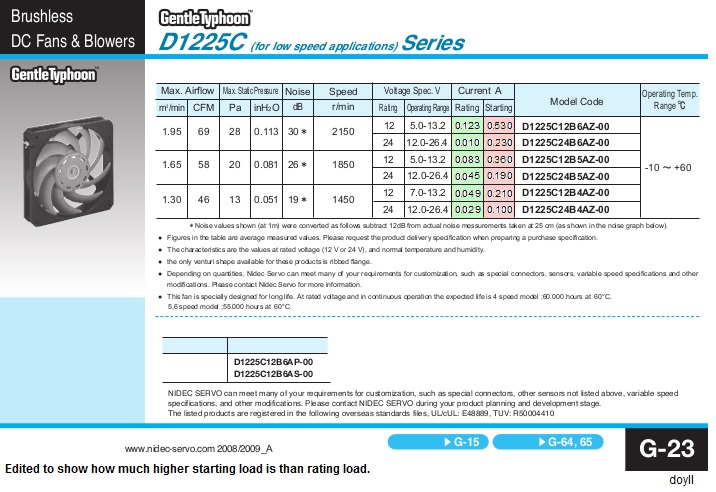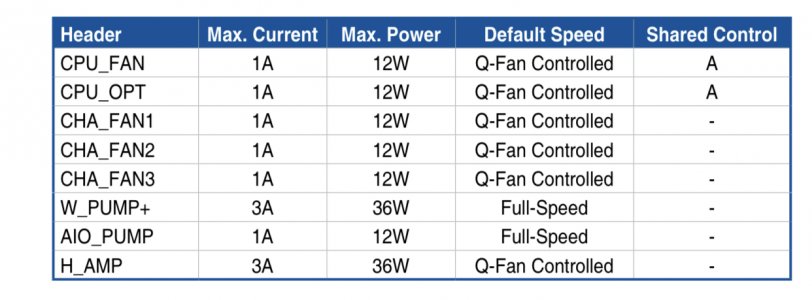Navigation
Install the app
How to install the app on iOS
Follow along with the video below to see how to install our site as a web app on your home screen.
Note: This feature may not be available in some browsers.
More options
You are using an out of date browser. It may not display this or other websites correctly.
You should upgrade or use an alternative browser.
You should upgrade or use an alternative browser.
How many 3-pin fans per mobo header
- Thread starter ZodaEX
- Start date
Depends how many amps the header has and how many amps the fan takes. Most MB fan headers only support 1 amp. You have to check you MB specs. Most fans typically consume around .25 amps. I wouldn't do more then 4 per header.I have a few 3-pin y-splitters for hooking up two case fans to a single motherboard header.
How many 3-pin fans could I run off of a single motherboard header and still be safe? Because I could hook another splitter into this splitter.
Typically motherboard fan headers will handle 1 amp of load. Problem is there is not "typical" fan power draw. Fans "typically" draw from 0.1amp to 1.0amp. Another problem is fan amp rating is running amp. This is the amp load fan draws while running .. but fan draws 3-6 times more power at startup or if impeller is stopped (like bearing seizes or something stop impeller turning. This is the reason most fan header failures occur when system is started (and fans start spinning). Chart below shows Nidec Servo running and startup load for Gentle Typhoon fans. You can see how much higher amp draw is at startup than while running. 1 milliamp is is 0.001 amp, 123 milliamp is 0.123 amp.

My rule of thumb is figure fan max draw is 5 times the specified running load. This means if fan is rated 0.12A it can draw up to 0.6A. So a fan header rated 1A is same to run only two fans rated 0.05A in fan specs.

My rule of thumb is figure fan max draw is 5 times the specified running load. This means if fan is rated 0.12A it can draw up to 0.6A. So a fan header rated 1A is same to run only two fans rated 0.05A in fan specs.
I usually assume a fan header doesnt want to supply more than 15W of power at any one time (12V * ~1A), so if the total wattage of the fans youre using is over 15W (amps times volts) then you may want to look into a fan controller/hub with external power.
Kinda hate to say it but 15w of 12V power is not 1A.I usually assume a fan header doesnt want to supply more than 15W of power at any one time (12V * ~1A), so if the total wattage of the fans youre using is over 15W (amps times volts) then you may want to look into a fan controller/hub with external power.
Volts X Amps = Watts
12V X 1A = 12 watts
12V X 1.25A = 15 watts
notarat
2[H]4U
- Joined
- Mar 28, 2010
- Messages
- 2,500
Typically motherboard fan headers will handle 1 amp of load. Problem is there is not "typical" fan power draw. Fans "typically" draw from 0.1amp to 1.0amp. Another problem is fan amp rating is running amp. This is the amp load fan draws while running .. but fan draws 3-6 times more power at startup or if impeller is stopped (like bearing seizes or something stop impeller turning. This is the reason most fan header failures occur when system is started (and fans start spinning). Chart below shows Nidec Servo running and startup load for Gentle Typhoon fans. You can see how much higher amp draw is at startup than while running. 1 milliamp is is 0.001 amp, 123 milliamp is 0.123 amp.
View attachment 369124
My rule of thumb is figure fan max draw is 5 times the specified running load. This means if fan is rated 0.12A it can draw up to 0.6A. So a fan header rated 1A is same to run only two fans rated 0.05A in fan specs.
Nice response.
I've been building systems with 10-12 fans lately so I've started using fan hubs to keep those start-up loads off the motherboard. It also helps out a little with the cable management too. I just make sure to use a higher quality hub because some of them being sold have very very small gauge power (sata/molex) input wires.
ThanksNice response.
I've been building systems with 10-12 fans lately so I've started using fan hubs to keep those start-up loads off the motherboard. It also helps out a little with the cable management too. I just make sure to use a higher quality hub because some of them being sold have very very small gauge power (sata/molex) input wires.
Yeah, some hubs have scary-small gauge wires. Still better to let the smoke out of one of them rather than motherboard and possible loss pf same. I didn't say it before, but most motherboard fan header fails are at startup .. when load is highest.
Kinda hate to say it but 15w of 12V power is not 1A.
Volts X Amps = Watts
12V X 1A = 12 watts
12V X 1.25A = 15 watts
Kinda hate to say it, but the ~ in front of 1A means "approximately", specifically, a "weak approximation". Two tildes above one another means a more accurate approximation, though I dont really know the alt code for that one, and I dont believe it would apply here anyway as a 25% delta isnt exactly "accurate".
I did also specifically mention in the post that watts = volts times amps.
pendragon1
Extremely [H]
- Joined
- Oct 7, 2000
- Messages
- 52,029
4 reg fans(~.2-.25 amp) per header unless its high amp.
While ≈ means approximately equal to, I can't find any definition at all for ~. Can you link me to it?Kinda hate to say it, but the ~ in front of 1A means "approximately", specifically, a "weak approximation". Two tildes above one another means a more accurate approximation, though I dont really know the alt code for that one, and I dont believe it would apply here anyway as a 25% delta isnt exactly "accurate".
I did also specifically mention in the post that watts = volts times amps.
But to be honest, I don't consider the answer to a mathematical calculation that is off by 25% to be "approximately" accurate .. and your 1.5w "approximation" is exactly that, 25% higher than 12v @ 1a. It's not hard to multiply 12 by 1 and post 12 watts instead of guessing and positing 1.5 .. unless you don't know how to do simple multiplication. Enough said.
Not all motherboards list fan header load specifications, but ones that do almost always are 1A ratung. I think your 3A / 36W header is for water pump and has no speed control / runs at 100% all the time.Find your motherboard manual and look at the limits per connector. The Dark Hero list the following…. So the answer really depends on your motherboard and the header you want to use.
While ≈ means approximately equal to, I can't find any definition at all for ~. Can you link me to it?
Certainly:
https://www.rapidtables.com/math/symbols/Basic_Math_Symbols.html - Scroll down to algebra symbols
https://www.pinterest.com/pin/130956301645332884/ - dozens of depictions of basic math symbols, which seem like they would be useful for you.
https://en.wikipedia.org/wiki/Glossary_of_mathematical_symbols#Arithmetic_operators - Subsection: Equality, equivalence and similarity
But to be honest, I don't consider the answer to a mathematical calculation that is off by 25% to be "approximately" accurate .. and your 1.5w "approximation" is exactly that, 25% higher than 12v @ 1a. It's not hard to multiply 12 by 1 and post 12 watts instead of guessing and positing 1.5 .. unless you don't know how to do simple multiplication. Enough said.
Thats fine, I probobly agree with that. Considering I was specifically referring to 1A being similar to 1.25A, and in no capacity making any claims towards the total accuracy of the equation I provided (the equation being 12 * 1 euqalling ~15, in case you didnt know what an equation was) I dont really see how your definition of accuracy even matters here?
and your 1.5w "approximation" is exactly that, 25% higher than 12v @ 1a. It's not hard to multiply 12 by 1 and post 12 watts instead of guessing and positing 1.5 .. unless you don't know how to do simple multiplication. Enough said.
Its almost like you just proved that I do understand basic math
Enough said.
LOLCertainly:
https://www.rapidtables.com/math/symbols/Basic_Math_Symbols.html - Scroll down to algebra symbols
https://www.pinterest.com/pin/130956301645332884/ - dozens of depictions of basic math symbols, which seem like they would be useful for you.
https://en.wikipedia.org/wiki/Glossary_of_mathematical_symbols#Arithmetic_operators - Subsection: Equality, equivalence and similarity
Thats fine, I probobly agree with that. Considering I was specifically referring to 1A being similar to 1.25A, and in no capacity making any claims towards the total accuracy of the equation I provided (the equation being 12 * 1 euqalling ~15, in case you didnt know what an equation was) I dont really see how your definition of accuracy even matters here?
Its almost like you just proved that I do understand basic math
Enough said.
And by proving you know rather techical math symbols, you make your 1A being ~15W even more of a fubar.
Glad you can take the ribbing in fun as it was intended!

LOL
And by proving you know rather techical math symbols, you make your 1A being ~15W even more of a fubar.
Glad you can take the ribbing in fun as it was intended!
Just like you
I do still think in the context of what power a fan header provides, the difference of 3W is enough to be classified as similar.
Sorry, but to me a 25% difference isn't "similar". 25% more power than an electrical circuit is rated for is a big difference, be it 3 watts on a 12 watt circuit or 30 watts on a 120w circuit.Just like you
I do still think in the context of what power a fan header provides, the difference of 3W is enough to be classified as similar.
Electrical circuits are supposed to have a 50% safety margin, but the often do not. Just look at wire size on PSU power cables and/or fan cables to see what I mean. What they do is use undersize wire depending on it's heat buildup being able to radiate away to keep it's temp reasonable. But if cables are bunch together too much they can still melt insulation. End result is a 25% overload can (sometimes does) result in cable loosing it's smoke (Lucas Electronics).
Last edited:
Sorry, but to me a 25% difference isn't "similar". 25% more power than an electrical circuit is rated for is a big difference, be it 3 watts on a 12 watt circuit or 30 watts on a 120w circuit.
Electrical circuits are supposed to have a 50% safety margin, but the often do not. Just look at wire size on PSU power cables and/or fan cables to see what I mean. What they do is use undersize wire depending on it's heat buildup being able to radiate away to keep it's temp reasonable. But if cables are bunch together too much they can still melt insulation. End result is a 25% overload can (sometimes does) result in cable loosing it's smoke (Lucas Electronics).
The question was specifically regarding fan headers, and how many fans they could support, which is effectively asking their maximum power output. This isnt some fantasy 120w circut, it is specifically the circut for fan headers on a motherboard, which is typically capable of delivering 1A of current, hence my statment about 12v * 1A, but it can sometimes deliver more, such as the board I have right now:
https://www.asrock.com/mb/amd/x399 taichi/index.asp
**The CPU Fan Connector supports the CPU fan of maximum 1A (12W) fan power. ***The CPU Optional/Water Pump Fan supports the water cooler fan of maximum 1.5A (18W) fan power.
15 is exactly halfway between 12 and 18, which is pretty good evidence to support my idea that fan headers deliver ~15W of power on average.
No idea what kind of "magic" pills you are taking, but your logic of "15 is exactly half way between 12 and 18" is not at all rational to anyone in real world.The question was specifically regarding fan headers, and how many fans they could support, which is effectively asking their maximum power output. This isnt some fantasy 120w circut, it is specifically the circut for fan headers on a motherboard, which is typically capable of delivering 1A of current, hence my statment about 12v * 1A, but it can sometimes deliver more, such as the board I have right now:
https://www.asrock.com/mb/amd/x399 taichi/index.asp
**The CPU Fan Connector supports the CPU fan of maximum 1A (12W) fan power. ***The CPU Optional/Water Pump Fan supports the water cooler fan of maximum 1.5A (18W) fan power.
15 is exactly halfway between 12 and 18, which is pretty good evidence to support my idea that fan headers deliver ~15W of power on average.
Seems you are grasping at imaginary straws mate.
Next you will be saying something like " 35 is half way between 20 and 50".
Above is equally crazy.
There average means nothing.
Each rating stands alone
There is no averaging involved. One is rated 12 watts and other is rated 18 watts. They cannot be averaged.
No idea what kind of "magic" pills you are taking, but your logic of "15 is exactly half way between 12 and 18" is not at all rational to anyone in real world.
Seems you are grasping at imaginary straws mate.
Next you will be saying something like " 35 is half way between 20 and 50".
Above is equally crazy.
There average means nothing.
Each rating stands alone
There is no averaging involved. One is rated 12 watts and other is rated 18 watts. They cannot be averaged.
I guess im not really sure how to proceed, 15 really is halfway between 12 and 18........just like 35 is for 20 and 50........whats 12 + 18 / 2? Whats 20 + 50 / 2? You legitimately dont seem to understand math in any meaningful capacity.
You dont seem to be trying to make any coherent points here either, youre posting in a thread about how many fans a single header can support, yet trying to argue about 15 not being equally in between 12 and 18......thats not normal.
The question posed was how many fans a single header can support, unless youre prepared to list every single motherboard one by one with the specific power capabilities, the best answer youre going to provide is an 'average". Which is 12V @ ~1A.
My board doesn't specify how many amps the headers are capable of. So I guess I'll stick to 3 or fewer to stay on the safe side.
That would be best, always better to play it safe. Though, assuming your board is the H61M-A:
https://dlcdnets.asus.com/pub/ASUS/mb/LGA1155/H61M-PLUS/E8184_H61M_Series.pdf - Page 1-26
"The two fan connectors support fans of maximum 2A (24 W) fan power."
I cant tell you for certain how that load is actually distributed on the circuit, but it would make sense to me that each header should be good for 1A.
We cannot average the load of 2 (or more) circuits to determine what safe load is (in this case fan header circuits). Each fan header circuit has it's own safe load. limit.I guess im not really sure how to proceed, 15 really is halfway between 12 and 18........just like 35 is for 20 and 50........whats 12 + 18 / 2? Whats 20 + 50 / 2? You legitimately dont seem to understand math in any meaningful capacity.
You dont seem to be trying to make any coherent points here either, youre posting in a thread about how many fans a single header can support, yet trying to argue about 15 not being equally in between 12 and 18......thats not normal.
The question posed was how many fans a single header can support, unless youre prepared to list every single motherboard one by one with the specific power capabilities, the best answer youre going to provide is an 'average". Which is 12V @ ~1A.
All your 'averaging' is doing is confusing the issue of what a safe load is for a fan header.
but when turned on and motors are starting to spin their startup load is 3-5 times higher than their running load, so your 0.6 amp running load for 3 fans is 1.8-3.0 amp while fans go from not turning to speed (usually full speed).My board doesn't specify how many amps the headers are capable of. So I guess I'll stick to 3 or fewer to stay on the safe side.
Again, almost all fan header failures happen when system is starting up and drawing 3-5 times more amps than the publish running load rating of our computer fans.
If you use PWM fans on PWM fan headers you can use PWM splitters / hubs that draw power directly from PSU. Using these PSU powered splitter / hubs you can control the speed of 8-10 fans with a single PWM fan header. There are a few fans that don't like these PWM splitter headers .. some Noctua fans will not speed control on these splitters.
And what is the safe load for each header circut? Without an average, I assume you are commited to providing data on every single possible motherboard ever made, otherwise, are you really trying to argue that it isnt easier to say ~1A? Once again, the question was specifically asking for an average, please not the lack of any specific board mentioned in the OP.We cannot average the load of 2 (or more) circuits to determine what safe load is (in this case fan header circuits). Each fan header circuit has it's own safe load. limit.
but when turned on and motors are starting to spin their startup load is 3-5 times higher than their running load, so your 0.6 amp running load for 3 fans is 1.8-3.0 amp while fans go from not turning to speed (usually full speed).
Again, almost all fan header failures happen when system is starting up and drawing 3-5 times more amps than the publish running load rating of our computer fans.
Would you say that the............average..............fan pulls 3 - 5 times more amps on startup? Whats even funnier, is you took issue with me approximating the difference between 1 and 1.25, and yet here you are claiming things can be anywhere from 3 to 5, a variance of well over 50%.
Nicely done.
Enough of this.And what is the safe load for each header circut? Without an average, I assume you are commited to providing data on every single possible motherboard ever made, otherwise, are you really trying to argue that it isnt easier to say ~1A? Once again, the question was specifically asking for an average, please not the lack of any specific board mentioned in the OP.
Would you say that the............average..............fan pulls 3 - 5 times more amps on startup? Whats even funnier, is you took issue with me approximating the difference between 1 and 1.25, and yet here you are claiming things can be anywhere from 3 to 5, a variance of well over 50%.
Nicely done.
There is no "approximate" or "average" in fan header ratings. Each header has it's own rating.
I don't think you would say "2" is "approximately" a "3"
Or that a "2" and a "3" can be averaged to be "2.5"
A "2" is a "2" and a "3" is a "3"
"2" cannot be averaged to "2.5" and neither can "3"
A 1 amp rated fan header is exactly that. 1 amp.
A 3 amp rated fan header is exactly that, 3 amp.
They cannot be averaged.
Each rating is it's own, no more, no less, no averaging.
Johnx64
[H]F Junkie
- Joined
- Apr 22, 2002
- Messages
- 9,256



Enough of this.
There is no "approximate" or "average" in fan header ratings. Each header has it's own rating.
I don't think you would say "2" is "approximately" a "3"
Or that a "2" and a "3" can be averaged to be "2.5"
A "2" is a "2" and a "3" is a "3"
"2" cannot be averaged to "2.5" and neither can "3"
A 1 amp rated fan header is exactly that. 1 amp.
A 3 amp rated fan header is exactly that, 3 amp.
They cannot be averaged.
Each rating is it's own, no more, no less, no averaging.
OK bud, things are things and math isnt real.
Math is real.OK bud, things are things and math isnt real.
You cannot use math average specifications.
Fan header ratings cannot be averaged with other fan headers rated 3.
1 amp rated fan header is safe to run a fan with a 1 amp startup load rating.
3 amp rated fan header is safe to run a fan with a 3 amp startup load rating.
Problem is fan amp ratings are running amps, not startup amps. Motor startup amp load is 3-5 times higher than running amp load.
Below is Nidec Servo Gentle Typoon fans specs show rating and startup amp loads.

You can see how much more power motor draws starting up than when running. If fan impeller is stopped (something gets into it or bearing seizes) motor draws same higher startup load load.
Again, this is why almost all fan header failures happen when system is starting up and fan motors are drawing this much higher amp load.
michalrz
Supreme [H]ardness
- Joined
- Jun 4, 2012
- Messages
- 4,336
Skimmed the thread; I could provide some power consumption curves for y'all.
I only have crappy fans, but would probably give an idea how they behave during spin-up (at least the 1st second with a 0.1s resolution), intake starvation, overpressuring, regular operation.
I only have crappy fans, but would probably give an idea how they behave during spin-up (at least the 1st second with a 0.1s resolution), intake starvation, overpressuring, regular operation.
Math is real.
You cannot use math average specifications.
Fan header ratings cannot be averaged with other fan headers rated 3.
What is the exact specification on the amount of power a fan header can deliver? Is it a range of watts or fixed? Is my 1.5A port out of spec? We are discussing power delivery of a port over a wide range of different models, theyll either need to be listed individually or averaged out to around 12V @ ~1A, if you want a more specific answer, ask a more specific question.
Youre also under the false impression that im attempting to average anything other than the amount of power a fan header can deliver. My claim was ~15W with 12V @ ~1A, which I still think is true, and its served me well for quite some time.
1 amp rated fan header is safe to run a fan with a 1 amp startup load rating.
3 amp rated fan header is safe to run a fan with a 3 amp startup load rating.
Problem is fan amp ratings are running amps, not startup amps. Motor startup amp load is 3-5 times higher than running amp load.
I completely agree with that, and never once claimed that to be anything other than accurate. Things are things.
I've had enough of your trolling babbly contradicting yourself. 1A rated head is safe to handle 1A, not an "average" of 1.2A.What is the exact specification on the amount of power a fan header can deliver? Is it a range of watts or fixed? Is my 1.5A port out of spec? We are discussing power delivery of a port over a wide range of different models, theyll either need to be listed individually or averaged out to around 12V @ ~1A, if you want a more specific answer, ask a more specific question.
Conversation is over.
I've had enough of your trolling babbly contradicting yourself. 1A rated head is safe to handle 1A, not an "average" of 1.2A.
Conversation is over.
So you cant provide factual information to backup your claim about power header specifications?
You continue to argue with yourself, a 1A header has always been safe for 1A, the rest of the sane world was trying to determine what a typical fan header provides, sort of like an......average........which turns out to be ~1A.
![[H]ard|Forum](/styles/hardforum/xenforo/logo_dark.png)
